Characterization of the Cracking Resistance Gradient of Bitumen Emulsion-Based Cold In-Place Recycling Mixtures over Curing by Semi-Circular Bending Test
Abstract
:1. Introduction
2. Scope and Objectives
- Investigate the gradient characteristics of the cracking resistance of BE-CIR mixture affected by water evaporation;
- Characterize the influence of factors including mixture design parameters and curing conditions on the gradient developmental behavior of fracture properties;
- Evaluate the influence of various factors on the fracture properties and gradient distribution.
3. Materials and Experimental Design
3.1. Materials
3.2. Specimen Preparation and Curing Conditions
3.3. Testing Program
3.4. SCB Test
4. Results
4.1. Water Loss
4.2. Performance Parameters from SCB and Gradient Distribution
4.2.1. Effect of Cement Content
4.2.2. Effect of Initial Moisture Content
4.2.3. Effects of Curing Temperature
4.2.4. Effects of Relative Humidity
4.3. Multifactor Analysis of Variance
5. Discussion of the Influencing Factors
6. Conclusions
- (1)
- The performance growth characteristics of BE-CIR mixes at various depths exhibited notable differences, evident through the top part’s higher tensile strength and fracture energy compared to the bottom part. This occurrence can be attributed to the non-uniform distribution of residual water within the mixture due to moisture evaporation. Consequently, this results in distinct microscopic morphologies and adhesive capabilities of the cement-emulsified asphalt mortar, ultimately leading to differences in crack resistance.
- (2)
- Increasing cement content can only improve the early tensile strength of the BE-CIR. Meanwhile, BE-CIR with higher cement content become stiffer and consequently less deformable, resulting in lower fracture energy. The initial moisture content mainly influenced the rate of water dissipation, but not the final residual moisture content. In addition, higher initial moisture content contributed to a more significant gradient characterization of the fracture properties due to the increase in residual water.
- (3)
- Elevating the temperature resulted in a considerable acceleration of water loss, leading to enhanced fracture properties and a reduction in the gradient index. In addition, during the initial stages of curing, high humidity prevented water dissipation from the mixture, which resulted in hindering the development of fracture resistance.
- (4)
- The findings indicated that the moisture migration process was governed by curing temperature and relative humidity, which were more significant than cement content and initial moisture content to the formation of cracking resistance performance. As for the gradient index of the fracture properties, the effect of curing temperature was the most significant, particularly after a curing period of 7 days.
Author Contributions
Funding
Institutional Review Board Statement
Informed Consent Statement
Data Availability Statement
Conflicts of Interest
References
- Wang, J.; Li, Q.; Lu, Y.; Luo, S. Effect of Waste-Oil regenerant on diffusion and fusion behaviors of asphalt recycling using molecular dynamics simulation. Constr. Build. Mater. 2022, 343, 128043. [Google Scholar] [CrossRef]
- Gu, F.; Ma, W.; West, R.C.; Taylor, A.J.; Zhang, Y. Structural performance and sustainability assessment of cold central-plant and in-place recycled asphalt pavements: A case study. J. Clean. Prod. 2019, 208, 1513–1523. [Google Scholar] [CrossRef]
- Turk, J.; Pranjić, A.M.; Mladenovič, A.; Cotič, Z.; Jurjavčič, P. Environmental comparison of two alternative road pavement rehabilitation techniques: Cold-in-place-recycling versus traditional reconstruction. J. Clean. Prod. 2016, 121, 45–55. [Google Scholar] [CrossRef]
- Stochino, F.; Alibeigibeni, A.; Milia, A.; Zucca, M.; Pani, L.; Simoncelli, M. Environmental and Economic Analysis of Using Recycled Concrete Aggregates in Composite Steel-Concrete Slabs. In Proceedings of the International Conference on Computational Science and Its Applications, Athens, Greece, 3–6 July 2023; pp. 277–288. [Google Scholar]
- Flores, G.; Gallego, J.; Miranda, L.; Marcobal, J.R. Cold asphalt mix with emulsion and 100% rap: Compaction energy and influence of emulsion and cement content. Constr. Build. Mater. 2020, 250, 118804. [Google Scholar] [CrossRef]
- Deb, P.; Lakshman Singh, K. Mix design, durability and strength enhancement of cold mix asphalt: A state-of-the-art review. Innov. Infrastruct. Solut. 2021, 7, 1–22. [Google Scholar] [CrossRef]
- Ouyang, J.; Pan, B.; Xu, W.; Hu, L. Effect of water content on volumetric and mechanical properties of cement bitumen emulsion mixture. J. Mater. Civ. Eng. 2019, 31, 04019085. [Google Scholar] [CrossRef]
- Golian, M.; Katibeh, H.; Singh, V.P.; Ostad-Ali-Askari, K.; Rostami, H.T. Prediction of tunnelling impact on flow rates of adjacent extraction water wells. Q. J. Eng. Geol. Hydrogeol. 2020, 53, 236–251. [Google Scholar] [CrossRef]
- Yang, Y.; Wang, H.; Yang, Y.; Zhang, H. Evaluation of the evolution of the structure of cold recycled mixture subjected to wheel tracking using digital image processing. Constr. Build. Mater. 2021, 304, 124680. [Google Scholar] [CrossRef]
- Lin, J.; Wei, T.; Hong, J.; Zhao, Y.; Liu, J. Research on development mechanism of early-stage strength for cold recycled asphalt mixture using emulsion asphalt. Constr. Build. Mater. 2015, 99, 137–142. [Google Scholar] [CrossRef]
- Grilli, A.; Graziani, A.; Bocci, E.; Bocci, M. Volumetric properties and influence of water content on the compactability of cold recycled mixtures. Mater. Struct. 2016, 49, 4349–4362. [Google Scholar] [CrossRef]
- Du, S. The optimum pre-mixing water content in asphalt emulsion mixture with cement. J. Test. Eval. 2021, 49, 4560–4575. [Google Scholar] [CrossRef]
- Jiang, J.; Zhao, Z.; Jiang, X.; Leng, Z.; Yang, B.; Ni, F. Moisture migration characterization of bitumen emulsion-based cold in-place recycling mixture over curing. Mater. Struct. 2023, 56, 122. [Google Scholar] [CrossRef]
- Raschia, S.; Mignini, C.; Graziani, A.; Carter, A.; Perraton, D.; Vaillancourt, M. Effect of gradation on volumetric and mechanical properties of cold recycled mixtures (CRM). Road Mater. Pavement Des. 2019, 20, S740–S754. [Google Scholar] [CrossRef]
- Miljković, M.; Poulikakos, L.; Piemontese, F.; Shakoorioskooie, M.; Lura, P. Mechanical behaviour of bitumen emulsion-cement composites across the structural transition of the co-binder system. Constr. Build. Mater. 2019, 215, 217–232. [Google Scholar] [CrossRef]
- Ziyani, L.; Gaudefroy, V.; Ferber, V.; Hammoum, F. A predictive and experimental method to assess bitumen emulsion wetting on mineral substrates. Colloids Surf. A Physicochem. Eng. Asp. 2016, 489, 322–335. [Google Scholar] [CrossRef]
- Kong, X.-M.; Liu, Y.-L.; Zhang, Y.-R.; Zhang, Z.-L.; Yan, P.-Y.; Bai, Y. Influences of temperature on mechanical properties of cement asphalt mortars. Mater. Struct. 2014, 47, 285–292. [Google Scholar] [CrossRef]
- Cardone, F.; Grilli, A.; Bocci, M.; Graziani, A. Curing and temperature sensitivity of cement–bitumen treated materials. Int. J. Pavement Eng. 2015, 16, 868–880. [Google Scholar] [CrossRef]
- Graziani, A.; Iafelice, C.; Raschia, S.; Perraton, D.; Carter, A. A procedure for characterizing the curing process of cold recycled bitumen emulsion mixtures. Constr. Build. Mater. 2018, 173, 754–762. [Google Scholar] [CrossRef]
- Orosa, P.; Pérez, I.; Pasandín, A. Short-term resilient behaviour and its evolution with curing in cold in-place recycled asphalt mixtures. Constr. Build. Mater. 2022, 323, 126559. [Google Scholar] [CrossRef]
- Xiao, F.; Amirkhanian, S.; Juang, C.H. Rutting resistance of rubberized asphalt concrete pavements containing reclaimed asphalt pavement mixtures. J. Mater. Civ. Eng. 2007, 19, 475–483. [Google Scholar] [CrossRef]
- Wang, D.; Guo, T.; Chang, H.; Yao, X.; Chen, Y.; Wang, T. Research on the performance of regenerant modified cold recycled mixture with asphalt emulsions. Sustainability 2021, 13, 7284. [Google Scholar] [CrossRef]
- Deng, C.; Jiang, Y.; Lin, H.; Chen, Z.; Ji, X. Influence of gradations on performance of emulsified asphalt cold recycled mixture produced using vertical vibration compaction method. Road Mater. Pavement Des. 2021, 22, 983–1003. [Google Scholar] [CrossRef]
- Zhang, J.; Zheng, M.; Pei, J.; Zhang, J.; Li, R. Research on low temperature performance of emulsified asphalt cold recycled mixture and improvement measures based on fracture energy. Materials 2020, 13, 3176. [Google Scholar] [CrossRef] [PubMed]
- Yang, Y.; Yue, L.; Cui, H.; Yang, Y. Simulation and evaluation of fatigue damage of cold recycled mixtures with bitumen emulsion. Constr. Build. Mater. 2023, 364, 129976. [Google Scholar] [CrossRef]
- Grilli, V.; Virgili, A.; Graziani, A. Evaluation of complex modulus and fatigue properties of cold recycled material mixtures using small-scale specimens. Road Mater. Pavement Des. 2023, 1–16. [Google Scholar] [CrossRef]
- Miljković, M.; Radenberg, M. Characterising the influence of bitumen emulsion on asphalt mixture performance. Mater. Struct. 2015, 48, 2195–2210. [Google Scholar] [CrossRef]
- Kuchiishi, A.K.; Vasconcelos, K.; Bariani Bernucci, L.L. Effect of mixture composition on the mechanical behaviour of cold recycled asphalt mixtures. Int. J. Pavement Eng. 2021, 22, 984–994. [Google Scholar]
- Abbasnejad, S.Y.; Modarres, A. Effect of setting accelerator additive on short-and long-term properties of cold recycled mixture containing bitumen emulsion–cement composites. Road Mater. Pavement Des. 2020, 21, 1932–1954. [Google Scholar] [CrossRef]
- Saadoon, T.; Gómez-Meijide, B.; Garcia, A. Prediction of water evaporation and stability of cold asphalt mixtures containing different types of cement. Constr. Build. Mater. 2018, 186, 751–761. [Google Scholar] [CrossRef]
- Saadoon, T.; Garcia, A.; Gómez-Meijide, B. Dynamics of water evaporation in cold asphalt mixtures. Mater. Des. 2017, 134, 196–206. [Google Scholar] [CrossRef]
- Kim, Y.; Im, S.; Lee, H.D. Impacts of curing time and moisture content on engineering properties of cold in-place recycling mixtures using foamed or emulsified asphalt. J. Mater. Civ. Eng. 2011, 23, 542–553. [Google Scholar] [CrossRef]
- Doyle, T.A.; McNally, C.; Gibney, A.; Tabaković, A. Developing maturity methods for the assessment of cold-mix bituminous materials. Constr. Build. Mater. 2013, 38, 524–529. [Google Scholar] [CrossRef]
- Graziani, A.; Godenzoni, C.; Cardone, F.; Bocci, M. Effect of curing on the physical and mechanical properties of cold-recycled bituminous mixtures. Mater. Des. 2016, 95, 358–369. [Google Scholar] [CrossRef]
- García, A.; Lura, P.; Partl, M.N.; Jerjen, I. Influence of cement content and environmental humidity on asphalt emulsion and cement composites performance. Mater. Struct. 2013, 46, 1275–1289. [Google Scholar]
- Fang, X.; Garcia, A.; Winnefeld, F.; Partl, M.N.; Lura, P. Impact of rapid-hardening cements on mechanical properties of cement bitumen emulsion asphalt. Mater. Struct. 2016, 49, 487–498. [Google Scholar] [CrossRef]
- Zhao, Z.; Jiang, J.; Chen, Z.; Ni, F. Moisture migration of bitumen emulsion-based cold in-place recycling pavement after compaction: Real-time field measurement and laboratory investigation. J. Clean. Prod. 2022, 360, 132213. [Google Scholar] [CrossRef]
- Zhao, Z.; Ni, F.; Zheng, J.; Cheng, Z.; Xie, S. Evaluation of Curing Effects on Bitumen Emulsion-Based Cold In-Place Recycling Mixture Considering Field-Water Evaporation and Heat-Transfer Conditions. Coatings 2023, 13, 1204. [Google Scholar] [CrossRef]
- Dot, J.P. Applied Manual for Asphalt Emulsion Cold In-Place Recycling Technology; Department of Transport of Jiangsu Province: Nanjing, China, 2010. (In Chinese) [Google Scholar]
- JTG E20-2011; Standard Test Methods of Bitumen and Bituminous Mixtures for Highway Engineering. Ministry of Transport of the People’s Republic of China: Beijing, China, 2011. (In Chinese)
- AASHTO TP 124-2018; Standard Method of Test for Determining the Fracture Potential of Asphalt Mixtures Using the Flexibility Index Test (FIT). American Association of State Highway and Transportation Officials: Washington, DC, USA, 2018.
- Du, H.; Ni, F.J.; Ma, X. Crack Resistance Evaluation for In-Service Asphalt Pavements by Using SCB Tests of Layer-Core Samples. J. Mater. Civ. Eng. 2021, 33, 04020418. [Google Scholar] [CrossRef]
- Xiao, F.; Yao, S.; Wang, J.; Li, X.; Amirkhanian, S. A literature review on cold recycling technology of asphalt pavement. Constr. Build. Mater. 2018, 180, 579–604. [Google Scholar]
- Li, Q.; Wang, J.; Song, S.; Wang, R.; Jiang, J.; Yan, C. Study on the Adhesion Characteristics of Asphalt-Aggregate Interface in Cold Recycled Asphalt Mixtures. J. Mater. Civ. Eng. 2023, 35, 04023283. [Google Scholar] [CrossRef]
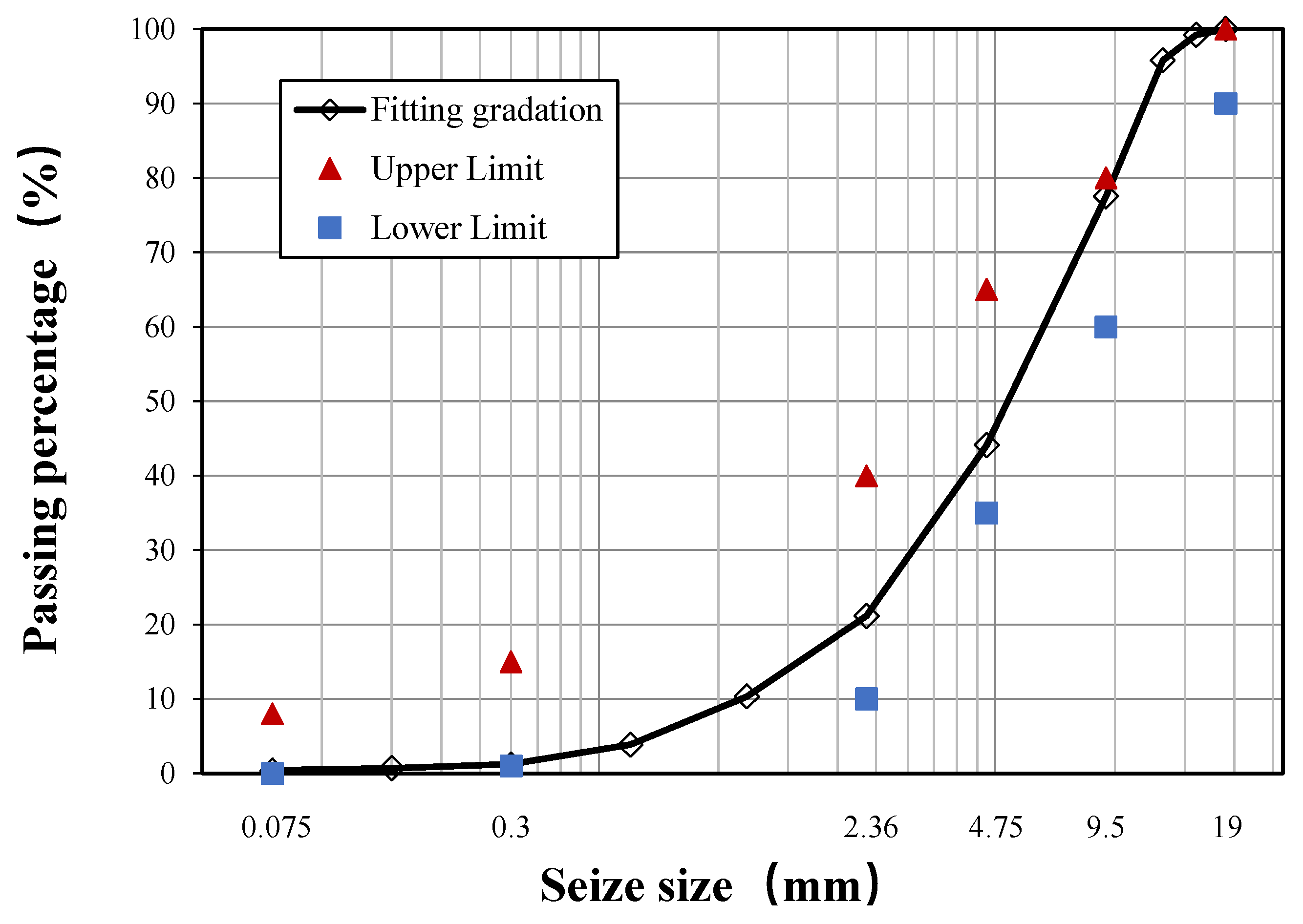
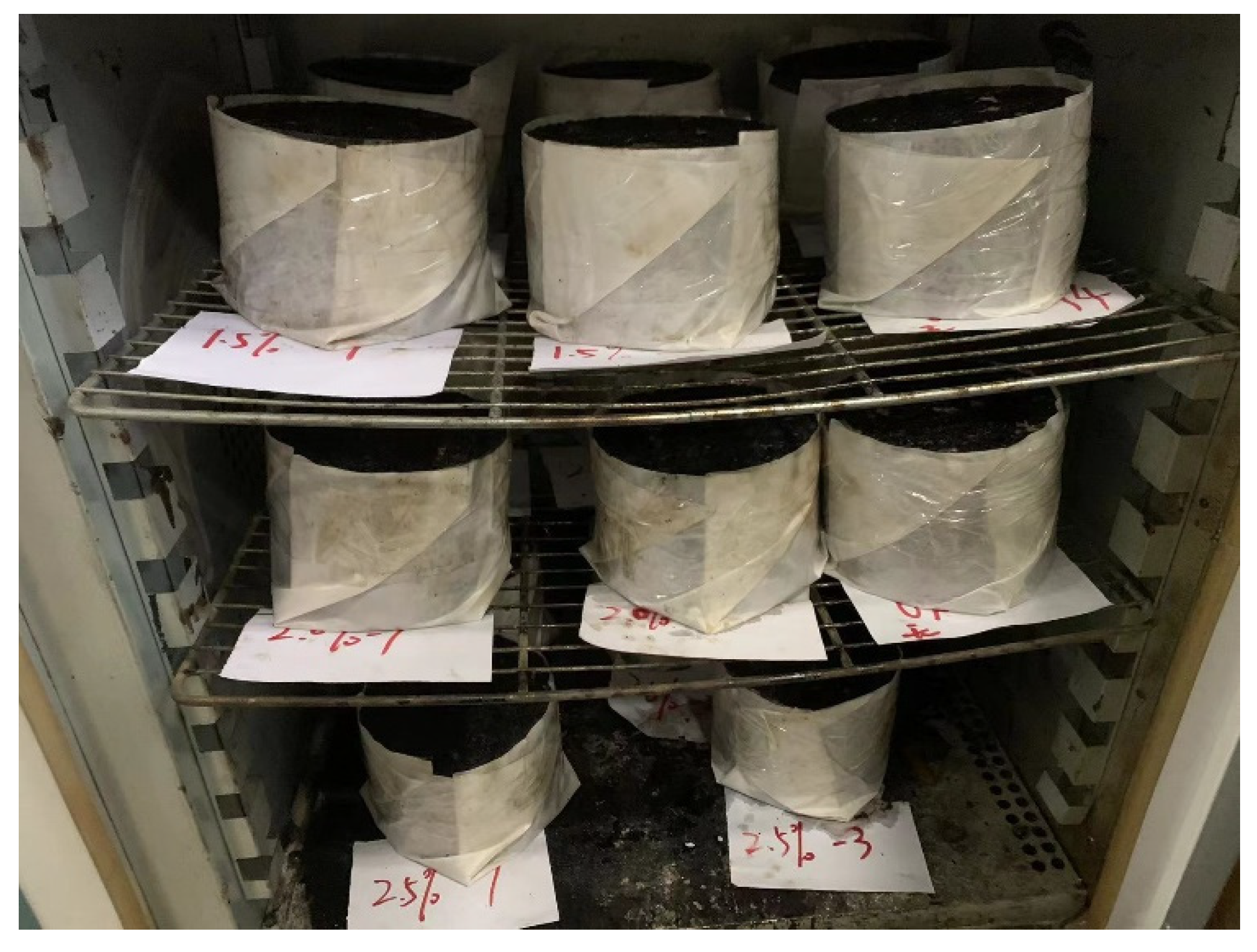
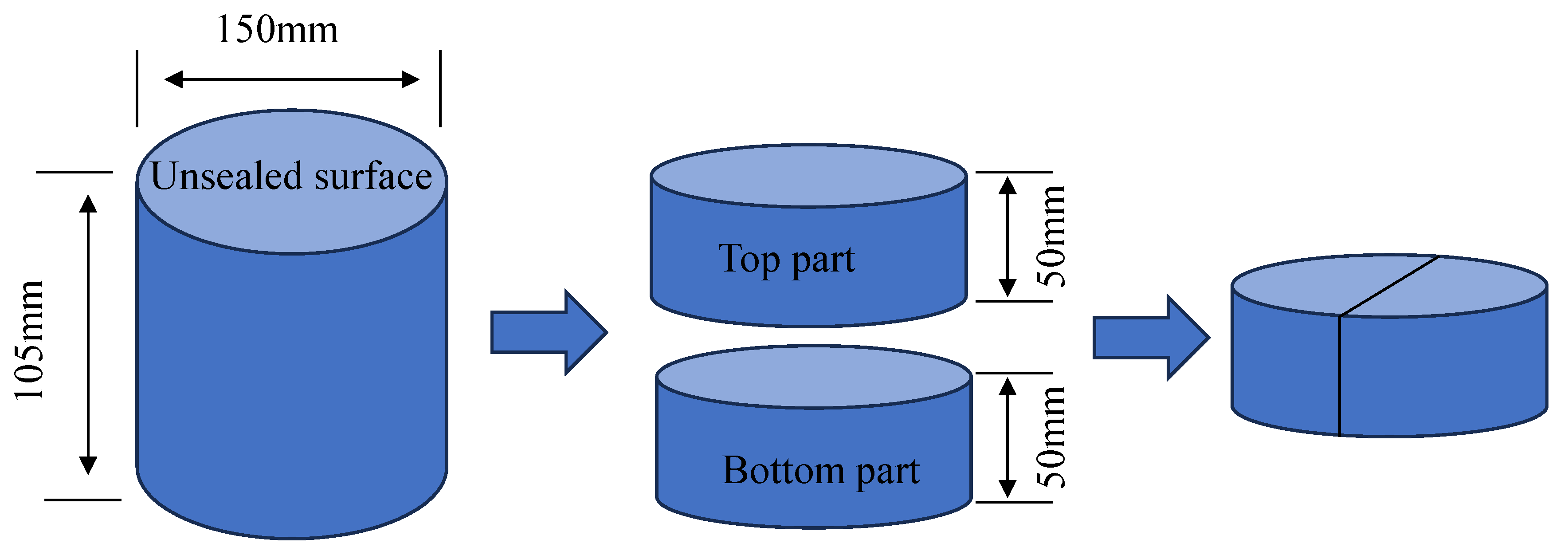
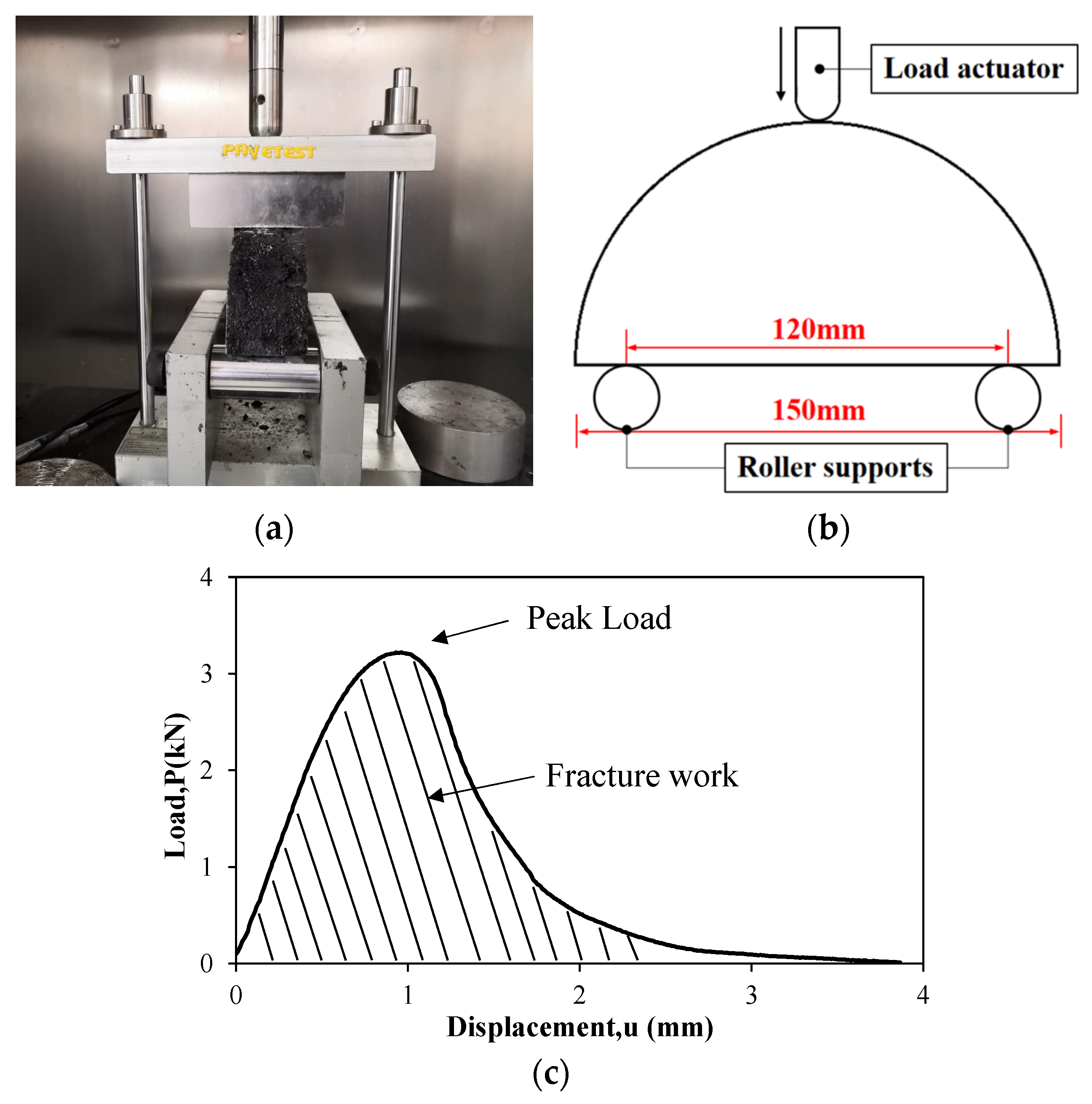
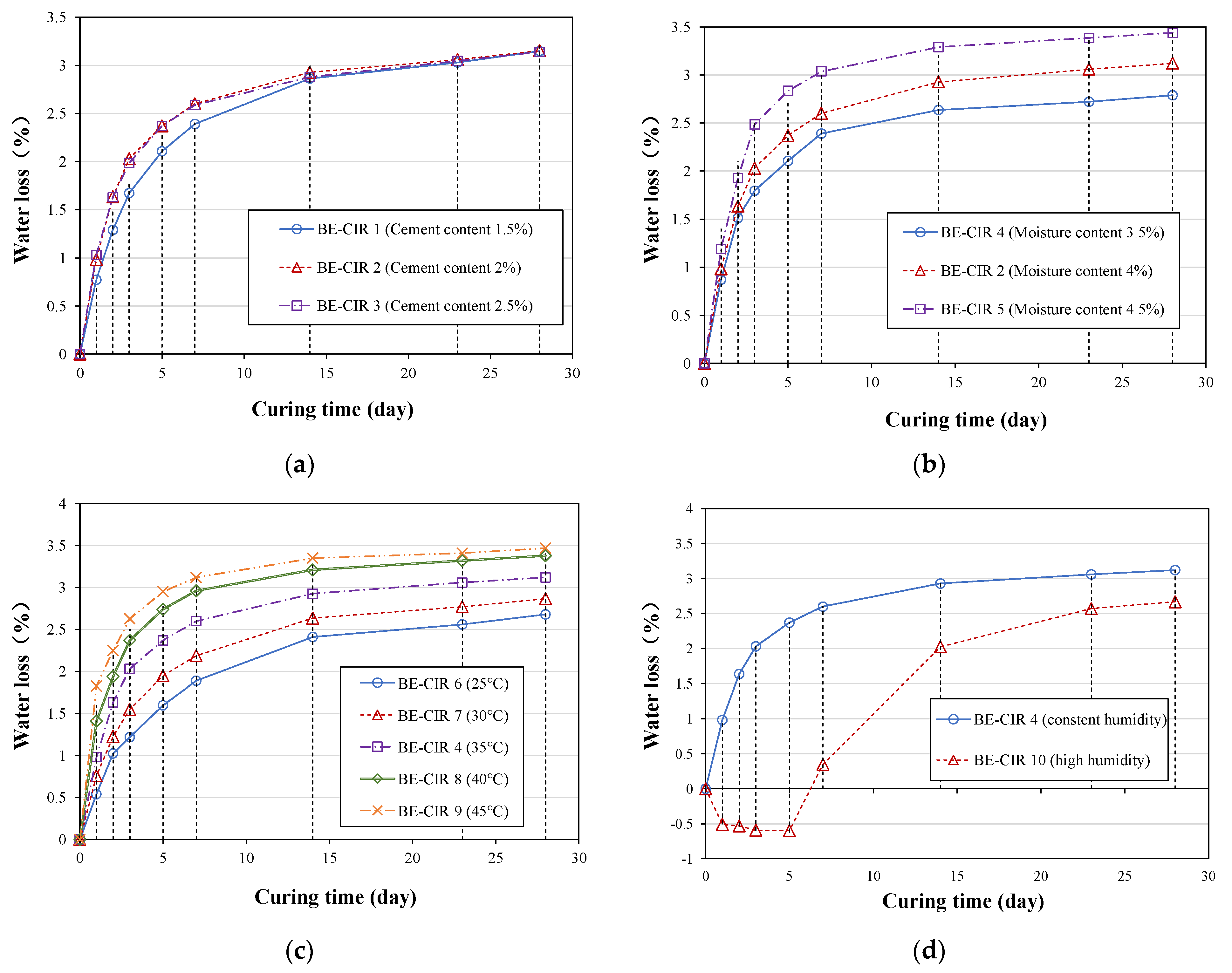

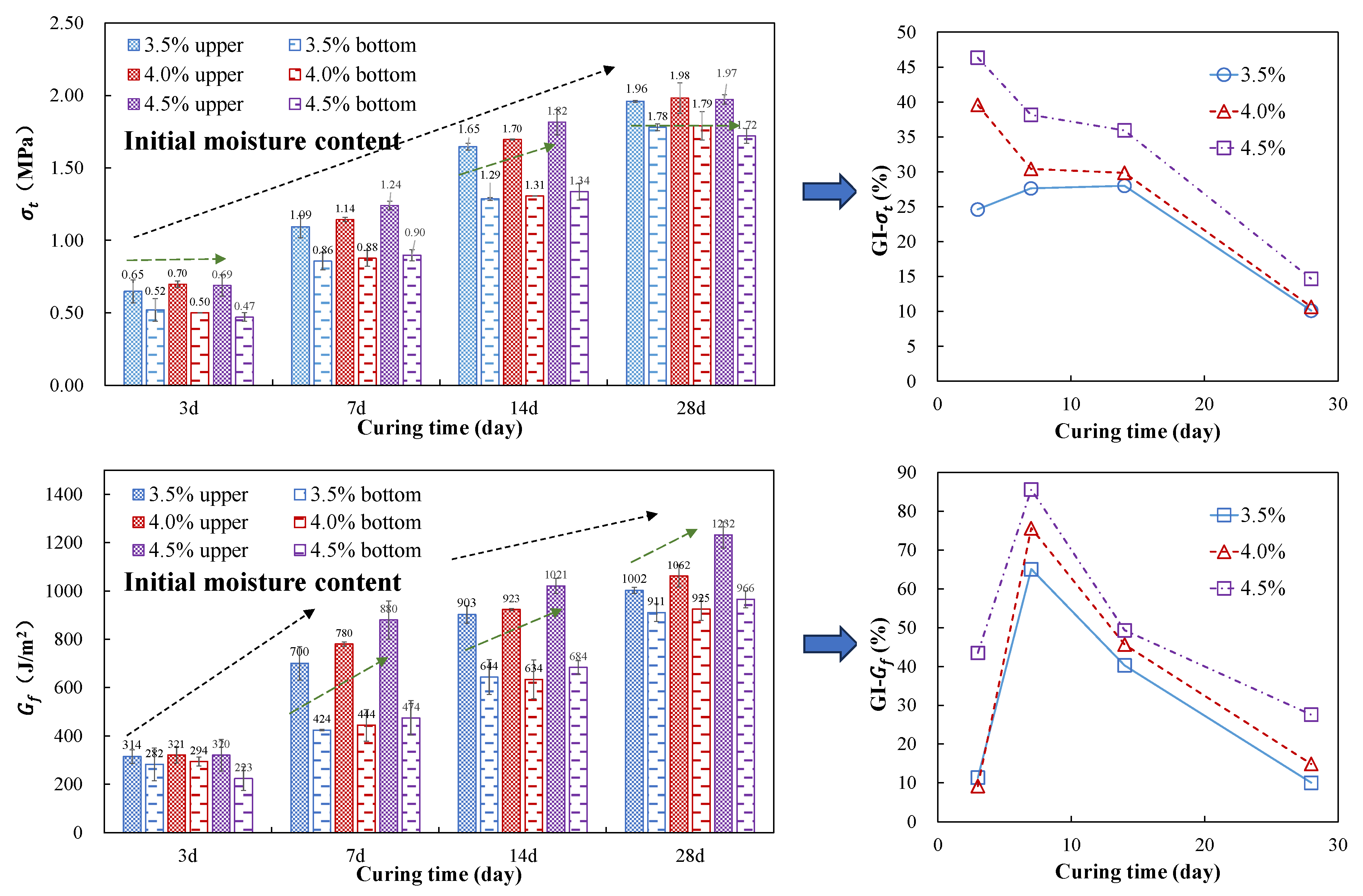
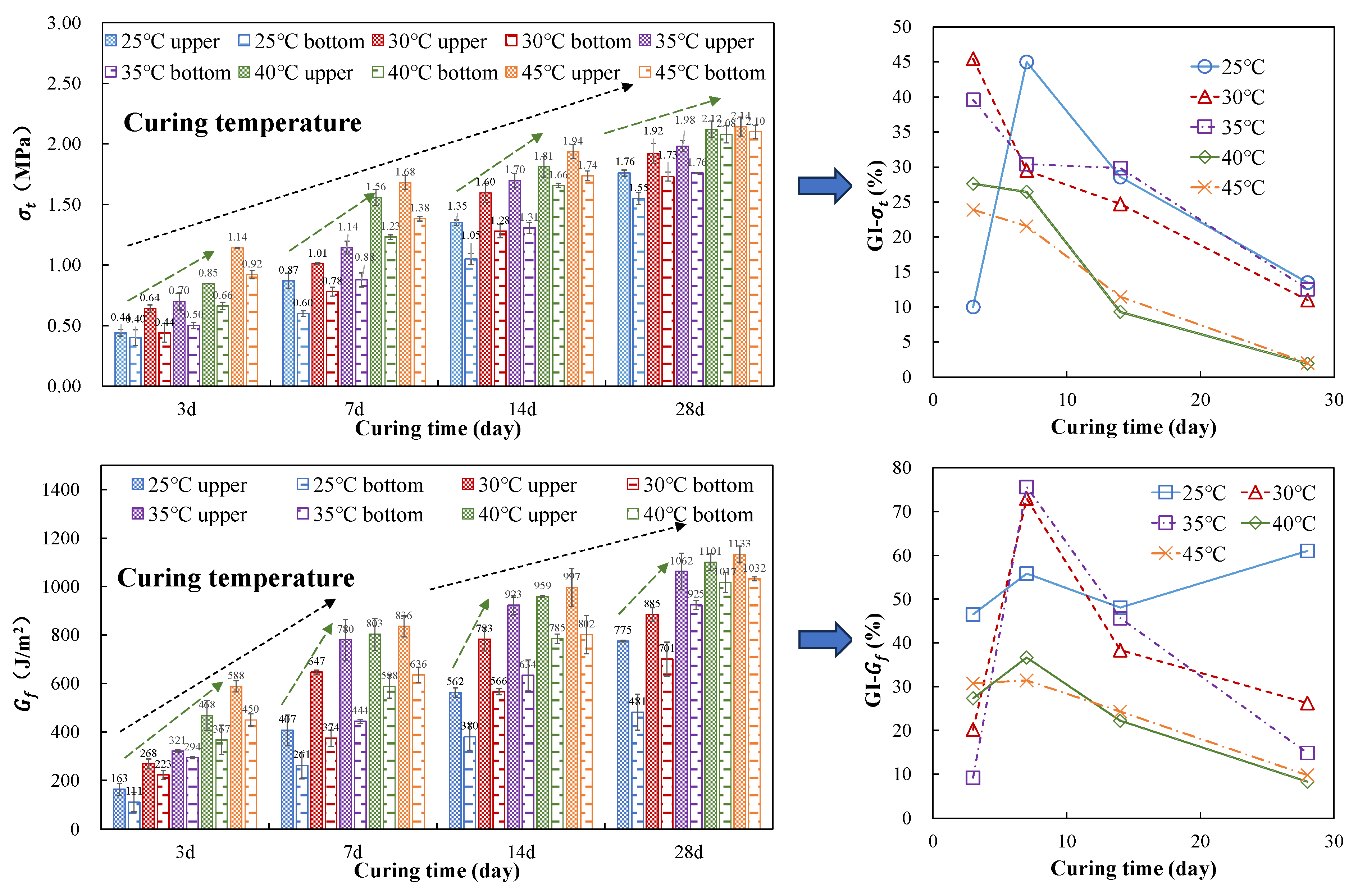
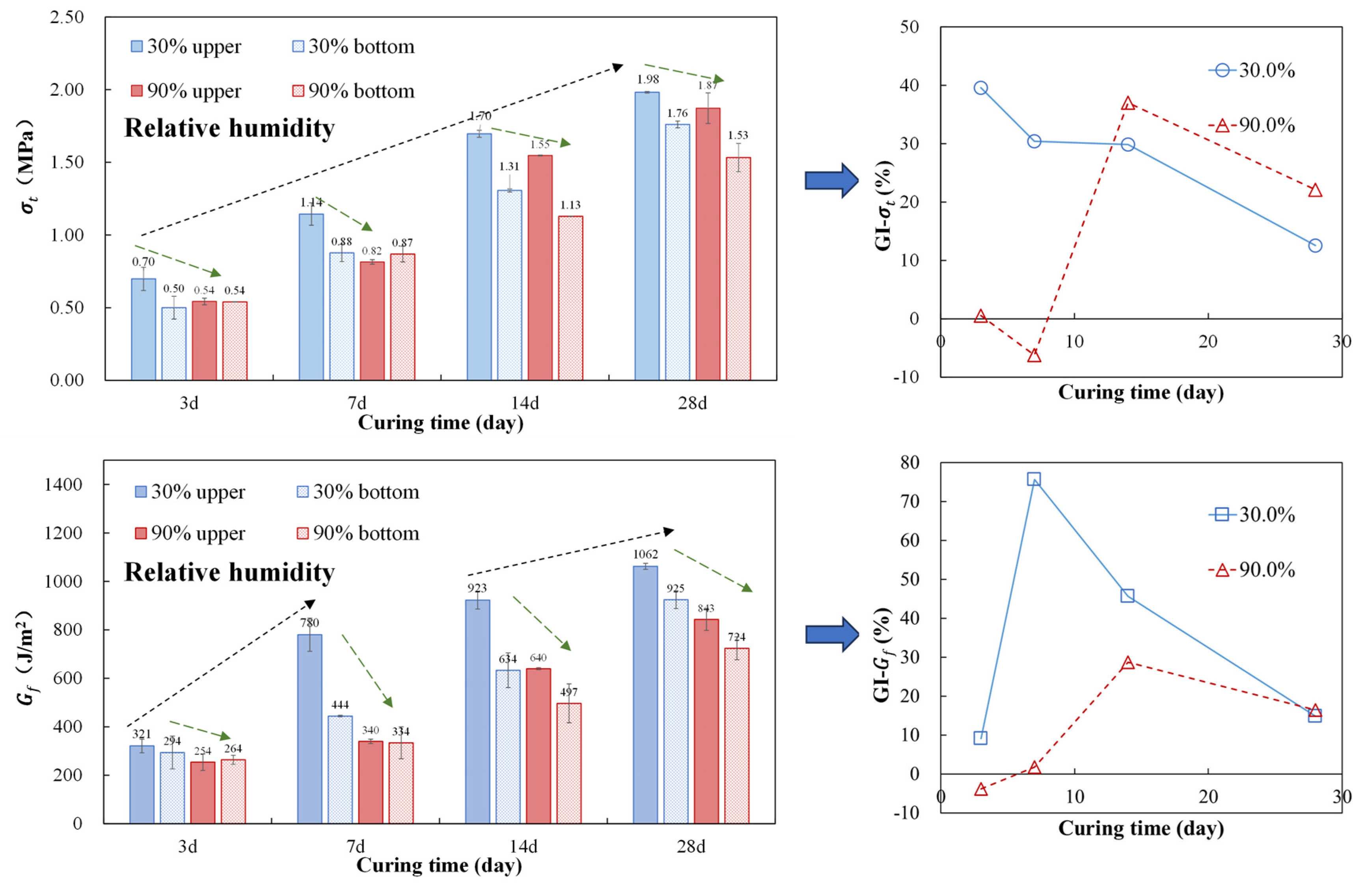
| Properties of the Emulsified Bitumen | Value | |
|---|---|---|
| Residue content (%) | 64 | |
| Penetration (25 °C; 0.1 mm) | 59.1 | |
| Soft point (°C) | 59.9 | |
| Ductility (15 °C; cm) | 110 | |
| Sieve residue (1.18 mm; %) | 0.03 | |
| Storage stability (5 d, 25 °C; %) | 1.47 | |
| Storage stability (1 d, 25 °C; %) | 0.42 | |
| Properties of Cement | ||
| Setting time (min) | Initial set | 3.14 |
| Final set | 4.62 | |
| Flexural strength (MPa) | 3 d | 4.9 |
| 28 d | 7.2 | |
| Compressive strength (MPa) | 3 d | 24.1 |
| 28 d | 51.4 | |
| Mix ID | Cement Content (%) | Initial Moisture Content (%) | Curing Temperature (°C) | Relative Humidity of Curing (%) |
|---|---|---|---|---|
| BE-CIR1 | 1.5 | 4 | 35 | 30% |
| BE-CIR 2 | 2 | |||
| BE-CIR 3 | 2.5 | |||
| BE-CIR 4 | 2 | 3.5 | ||
| BE-CIR 5 | 4.5 | |||
| BE-CIR 6 | 4 | 25 | ||
| BE-CIR 7 | 30 | |||
| BE-CIR 8 | 40 | |||
| BE-CIR 9 | 45 | |||
| BE-CIR 10 | 35 | 90% (first 5 days) |
| p-Value | Top Layer | Bottom Layer | ||||||
|---|---|---|---|---|---|---|---|---|
| 3 d | 7 d | 14 d | 28 d | 3 d | 7 d | 14 d | 28 d | |
| Factors | ||||||||
| Cement content | 0.0018 | 0.8175 | 0.8047 | 0.7591 | 0.1292 | 0.3635 | 0.6669 | 0.4106 |
| Initial moisture content | 0.6732 | 0.2672 | 0.1855 | 0.8778 | 0.6322 | 0.7351 | 0.7579 | 0.7195 |
| Curing temperature | <0.0001 | <0.0001 | 0.0007 | 0.0001 | 0.0005 | <0.0001 | 0.001 | 0.0038 |
| Relative humidity | 0.0211 | 0.0042 | 0.2022 | 0.0726 | 0.9652 | 0.6468 | 0.1225 | 0.0787 |
| Factors | ||||||||
| Cement content | 0.5065 | 0.4467 | 0.0083 | 0.0013 | 0.2497 | 0.091 | 0.0544 | 0.0228 |
| Initial moisture content | 0.8663 | 0.5907 | 0.3563 | 0.1447 | 0.6329 | 0.6269 | 0.5379 | 0.6985 |
| Curing temperature | <0.0001 | 0.011 | 0.0046 | 0.0014 | 0.0001 | 0.001 | 0.0019 | 0.002 |
| Relative humidity | 0.2641 | 0.045 | 0.6027 | 0.4465 | 0.0047 | 0.799 | 0.8142 | 0.3328 |
| p-Value | GI | |||
|---|---|---|---|---|
| 3 d | 7 d | 14 d | 28 d | |
| Factors | ||||
| Cement content | 0.1199 | 0.0236 | 0.6743 | 0.2873 |
| Initial moisture content | 0.2592 | 0.0558 | 0.5349 | 0.5541 |
| Curing temperature | 0.6127 | 0.0022 | 0.0534 | 0.0578 |
| Relative humidity | 0.008 | <0.0001 | 0.2465 | 0.0918 |
| Factors | ||||
| Cement content | 0.7288 | 0.0962 | 0.029 | 0.001 |
| Initial moisture content | 0.1566 | 0.8608 | 0.6378 | 0.0839 |
| Curing temperature | 0.7818 | 0.8263 | 0.0210 | 0.0095 |
| Relative humidity | 0.071 | 0.0007 | 0.1634 | 0.6983 |
Disclaimer/Publisher’s Note: The statements, opinions and data contained in all publications are solely those of the individual author(s) and contributor(s) and not of MDPI and/or the editor(s). MDPI and/or the editor(s) disclaim responsibility for any injury to people or property resulting from any ideas, methods, instructions or products referred to in the content. |
© 2023 by the authors. Licensee MDPI, Basel, Switzerland. This article is an open access article distributed under the terms and conditions of the Creative Commons Attribution (CC BY) license (https://creativecommons.org/licenses/by/4.0/).
Share and Cite
Zhao, Z.; Jiang, J.; Ni, F. Characterization of the Cracking Resistance Gradient of Bitumen Emulsion-Based Cold In-Place Recycling Mixtures over Curing by Semi-Circular Bending Test. Coatings 2024, 14, 46. https://doi.org/10.3390/coatings14010046
Zhao Z, Jiang J, Ni F. Characterization of the Cracking Resistance Gradient of Bitumen Emulsion-Based Cold In-Place Recycling Mixtures over Curing by Semi-Circular Bending Test. Coatings. 2024; 14(1):46. https://doi.org/10.3390/coatings14010046
Chicago/Turabian StyleZhao, Zili, Jiwang Jiang, and Fujian Ni. 2024. "Characterization of the Cracking Resistance Gradient of Bitumen Emulsion-Based Cold In-Place Recycling Mixtures over Curing by Semi-Circular Bending Test" Coatings 14, no. 1: 46. https://doi.org/10.3390/coatings14010046
APA StyleZhao, Z., Jiang, J., & Ni, F. (2024). Characterization of the Cracking Resistance Gradient of Bitumen Emulsion-Based Cold In-Place Recycling Mixtures over Curing by Semi-Circular Bending Test. Coatings, 14(1), 46. https://doi.org/10.3390/coatings14010046







